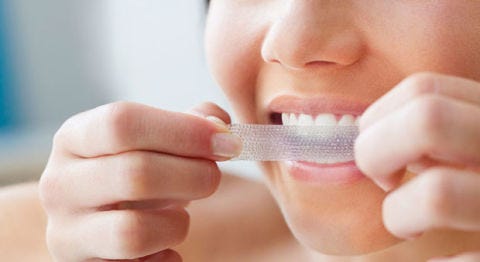Better Homes And Gardens Tooth Whitening

Jose Luis Pelaez, Inc./Getty Images
1. Time it right.
For best results, use an after a professional cleaning, says New York City cosmetic dentist Brian Kantor. "If there's plaque on your teeth, the bleach won't easily penetrate the enamel or lighten its color," he says. A thorough at-home brushing will also help. One caveat: "If you have especially sensitive teeth, you may feel more discomfort if you bleach immediately after brushing, so wait 30 minutes to an hour before you use a whitener," says dentist Silvia Bilobron of Short Hills, New Jersey.
2. Soothe sensitivity.
It's a common side effect most people experience, typically for a day or two. "The chemical reaction of bleaching opens the microscopic channels in teeth, causing discomfort," says Kantor. Using a toothpaste for sensitive teeth can help lessen the pain. Consuming acidic foods and beverages, like grapefruit or orange juice, can increase sensitivity as well, so avoid these while whitening and for up to a week afterward, adds Bilobron.
3. Prevent new stains.
For even better results, stay away from staining foods and beverages during and after whitening. The small channels in your teeth remain open for a few days afterward, which makes teeth susceptible to stains. Avoid common culprits like red wine, coffee, blueberries, grape juice, tea, and tomato sauce: "If it can stain a white T-shirt, it's likely to stain your teeth," says Kantor.

Getty Images
4. Go electric.
Swap your manual toothbrush for an electric version. "Most people don't brush properly or for long enough. A powered toothbrush with a self-timer compensates for that," says Joseph Banker, a dentist in Westfield, New Jersey. While brushing alone won't give you dramatic results, "daily use of an electric toothbrush paired with a whitening toothpaste is the most effective way to maintain whitening results," adds New York City dentist Michael Apa.
5. Rinse, don't brush.
After eating or drinking something staining, your natural inclination may be to brush right away, but you should wait at least 30 minutes. "Brushing immediately afterward can push pigments and the enamel-eroding acid in things like wine or dark soda into teeth rather than remove them," says New York City cosmetic dentist Nancy Rosen. Rinse with water, and then wait. Your saliva will naturally wash away some of these elements.

Jose Luis Pelaez, Inc./Getty Images
6. Don't overdo it.
In-office bleaching should be done no more than once a year, says Kantor, but because over-the-counter products don't have the same high concentrations of bleach, you can use them regularly without any risk of damage. The safest bet: Follow product instructions.
7. Brighten with toothpaste.
If you have a mouthful of dental work, you may want to skip at-home whiteners. "Bleaching won't whiten porcelain veneers, crowns, or white (porcelain or composite) fillings, so you could wind up with teeth that look mismatched in color," says Kantor. "Besides practicing good oral hygiene, the best way to keep veneers bright and clean is to brush twice a day with a toothpaste that contains silica, like a whitening paste."
This content is created and maintained by a third party, and imported onto this page to help users provide their email addresses. You may be able to find more information about this and similar content at piano.io
Better Homes And Gardens Tooth Whitening
Source: https://www.goodhousekeeping.com/health/wellness/a24621/at-home-tooth-whitening/
Posted by: hernandezflery1974.blogspot.com

0 Response to "Better Homes And Gardens Tooth Whitening"
Post a Comment